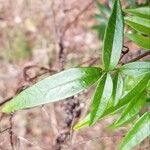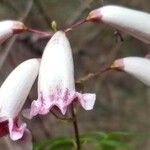Vigorous liane. Lvs petiolate, with (3)-5-7-(9) leaflets; leaflets 1.5-6 × 0.7-4 cm, lanceolate-ovate to ± oblong, usually entire, sometimes serrate in upper 1/2; base cuneate to rounded, often oblique in lateral leaflets; apex usually mucronate. Panicles of very numerous fragrant fls; peduncles and pedicels puberulent or glabrous. Calyx 3-4 mm long; teeth short and acute, puberulent or glabrous. Corolla 1.7-2.3 cm long, white or cream outside, variously marked with crimson or deep red inside; tube 1-1.5 cm long, broadly cylindric, slightly curved on upper side, glabrous; lobes broad-ovate to suborbicular, densely hairy on both surfaces, patent at first, later recurved; upper lobes to 4 mm long; lower lobes to 6 mm long. Ovary and style ± puberulent. Capsule c. 9 × 2 cm including beak. Seeds 2-2.5 cm wide including wing.


